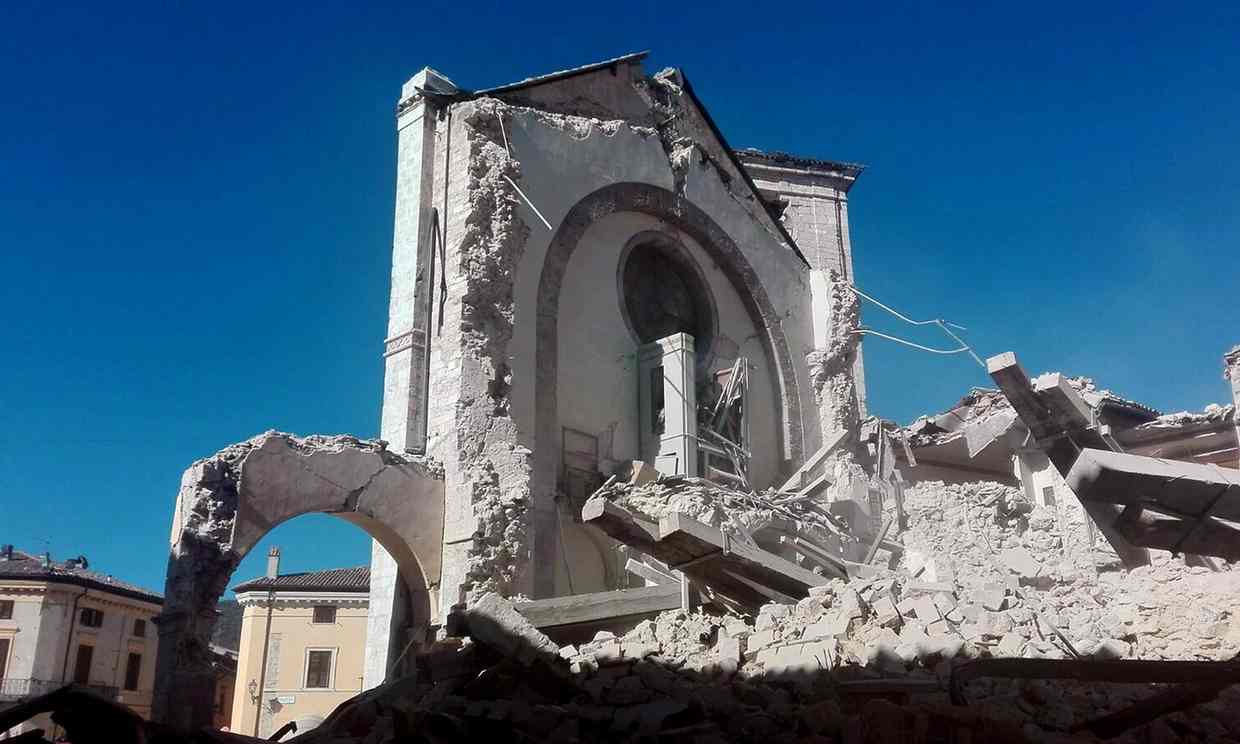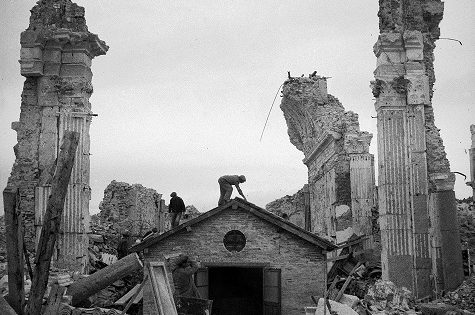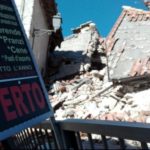On October 30, 2016 another tremendous earthquake hit central Italy again, the greatest one in the last decades of a series that started in August, killed almost 300 people and destroyed the cultural treasures of the medieval small towns and villages scattered along the Apennines. The news came to me as I was spending my Halloween weekend in the splendid Golfo dei Poeti in Liguria and enjoying the natural and artistic beauty offered by our land. To recall the terrible event and its tragic consequences for our art treasures, I report the Guardian’s article Italy’s earthquake affects us all – theirs is a cultural richness like no other: “from Pompeii to Florence to Norcia, the people of Italy have lived with disaster for millennia. Out of that instability they created beauty. Any loss of that great human fabric is a loss for us all.”
It is a gorgeous day, here in the Golfo dei Poeti that surrounds the town of La Spezia in the Eastern riviera ligure. As some readers of mine know, this is my summer’s hideaway beneath the waves, a thing of beauty, a joy forever, and no wonder Percy B. Shelley and Lord Byron made this place their home. Summer around here lasts from May to October and in this Halloween weekend I am here to celebrate the end of the season that up to now has given no sign of departure: the beaches are still crowded, the water is warm for swimming and open air life is pleasant. So here I am in a little cafe at lunch time, overlooking the bay and taking the picture shown above. On this side of the bay I can see the castle of Lerici, a medieval fortification whose present shape was carved in the Renaissance, and on the other side I can get a glimpse of the church of San Pietro, a XIII century nice example of Genovese Gothic architecture, whose stunning position at the top of a cliff at the western end of the village of Porto Venere and its panoramic views have made it famous. Next to it there is the famous Byron grotto, an inspirational place for the poet who “as a daring swimmer defied the waves of the sea from Porto Venere to Lerici”, as the sign reads. Indeed There is a pleasure in the pathless woods, There is a rapture on the lonely shore, There is society, where none intrudes, By the deep Sea, and music in its roar: I love not Man the less, but Nature more, From these our interviews, in which I steal From all I may be, or have been before, To mingle with the Universe, and feel What I can ne’er express, yet cannot all conceal. As I watch the panorama I recall the words from a book titled the Italians by John Hooper I have recently reviewed: the author quotes Italy’s world famous landmarks and then adds that there are others scattered across Italy that few foreigners have heard of … that house more cultural treasures that are to be found in entire U.S. states. Today, I think to myself, the sun, the wind, the sea and the beauty of the landscape hide the the dark sides of the Italian society. For now I have almost forgotten that yesterday another tremendous earthquake hit central Italy again, the greatest one in the last decades of a series that started in August, killed almost 300 people and destroyed the cultural treasures of the medieval small towns and villages scattered along the Apennines, “the beautiful country the Apennines divide, and Alps and sea surround” in Petrarch’s words.
But all of a sudden the tragic recollection, that the place in which I find myself has hidden, is brought to me again by an email I receive in that very moment from a book marketing agent I have been working with, Emanuele Properzi, who lives in the small seaside village of Porto Sant’Elpidio in the Marche region, 60 kilometres away from the quake’s epicenter. Emanuele and his family are alright but the shock has been profound and his anxiety has given birth to this emotional email, whose invitation I gladly fulfill. Emanuele writes:
(…) il ricordo di paesi meravigliosi, vere e proprie perle appenniniche che non ci sono più. Amtarice, Arquata, Castelsant’Angelo, Norcia, Visso, Ussita ecc.. Non ci sono più. Visitarle era una esperienza indimenticabile. Avresti incontrato persone di un’accoglienza e umanità uniche. Una gastronomia favolosa, dei paesaggi incantevoli, un patrimonio artistico non così noto come in altre città, ma assolutamente di primo rilievo. Oltre alle vite umane, abbiamo perso tutto questo, per sempre. E’ questo pensiero che vorrei che facessi. E … magari una preghiera per queste anime colpite non farebbe male. Sarebbe poi fantastico, tu che sai scrivere, se scrivessi un post sui social network in ricordo di questi posti incantevoli che non ci sono più (…) 31 October 2016, 14.09
(… the memory of wonderful villages, real Apennines pearls that are gone. Amtarice, Arquata, Castelsant’Angelo, Norcia, Visso, Ussita etc.. They are gone. Visiting them was an unforgettable experience. You would have met people of warm and unique humanity. Fabulous cuisine, beautiful landscapes, an artistic heritage not as well known as in other cities, but absolutely of great importance. In addition to human lives, we have lost all this, forever. This is what I would like you to think about. And … maybe say a prayer for these wounded souls. Then it would be great if you, as a writer, wrote a post on social networks in memory of these beautiful places that have disappeared …)
When I look again at the gulf below it is as if a strange fog has made the view grey and dim, as if the sun could not give brilliance to the scene. And the sea, and Nature in general, is now revealing not only its beauty but also its destroying force, the image of the sublime which is glamorous in art but devastating in reality, a force man cannot halt, … the vile strength he [mankind] wields / For earth’s destruction thou dost all despise in Byron’s words again. Indeed in my country man has challenged nature throughout the course of history, building villages on fragile ground and in mountain locations hard to reach, building the monuments which established his and the nation’s identity on turbulent soil in his attempt to master the land. Don’t get me wrong, there is no negative understatement in this last sentence, negativity lies in recent speculations of corrupt constructors who built fragile houses in dangerous zones and who were recorded laughing and joking after the 2009 L’Aquila earthquakes. With hundred of casualties still scattered around the land, they were thinking about the huge amount of money they would make with reconstruction thanks to their political liaisons with corrupt politicians who would grant them public contracts. This is the dark side of the Italian society that always steps in the way: Italia! oh Italia! thou who hast / The fatal gift of beauty, which became / A funeral dower of present woes and past writes Byron.
It seems to me that the best words about this tragic event were written on the same day by the Guardian‘s art columnist Jonathan Jones in the article Italy’s earthquake affects us all – theirs is a cultural richness like no other which I report hereafter. His final sentence is a statement that has it all: “from Pompeii to Florence to Norcia, the people of Italy have lived with disaster for millennia. Out of that instability they created beauty. Any loss of that great human fabric is a loss for us all.”

The Basilica of San Benedetto after the earthquake in Norcia. Photograph: Matteo Guidelli/EPA, from the Guardian
Buildings are not people. It is an immense mercy that, so far as is currently known, there were no fatalities in the latest earthquake to hit central Italy. Yet I can’t help mourning the basilica of St Benedict in Norcia. To see such a beautiful old building destroyed is gut-wrenching.
While the images suggest restoration may salvage at least an echo of this medieval church, the loss of this and other ancient buildings in a 6.6-magnitude earthquake that has left a surreal maze of wreckage over the Norcia region will break the heart of any art lover.If I have not even visited this Benedictine abbey church, why am I sad? Because it epitomises everything wonderful about Italy. Nowhere else has quite the same artistic and historical richness as the Italian peninsula. In towns up and down the country, layers of time intersect, and artistic treasures are part of everyday life. The basilica in Norcia was built over the reputed birthplace of Saint Benedict himself, who in the sixth century AD founded the abbey of Monte Cassino in southern Italy and wrote the Rule of St Benedict, the blueprint for western monasticism that sets out a code of practice for communities of celibate men or women living, working and praying together.Monte Cassino was destroyed in the second world war. Now, the basilica of San Benedetto has been smashed by nature. Is it OK to admit that I am sadder about such damage in Italy than anywhere else?Itay’s cultural greatness defies its geological instability. From the cathedral of Orvieto, high above the Umbrian plain, to the narrow, steep streets of Siena, this is a land of people who have built into the sides of hills, mountains and precipices. Wherever you go in the country you will find staircases up steep hills and churches clinging to cliffs.It’s that organic sense of continuity and deep time that makes Italian towns and cities so captivating. You can picture medieval life here, can feel the presence of generation upon generation. So much life is embodied in Italy’s stones. So many stories haunt every alley and cloister. It seems that churches like the basilica of St Benedict will never vanish. Until they do.
Natural disaster is not new in Italy. Urban civilisation in this geologically turbulent region has always lived with risk. Pompeii and Herculaneum are preserved as archaeological wonders because they were buried by Vesuvius in AD79. People are still living on the slopes of Vesuvius, hoping that nothing will go wrong. In the town of Pozzuoli on the edge of a huge volcanic area to the north of Naples, a section of the harbour is deserted after an earthquake here in 1983. But the sinister dead section of the town does not stop thousands of people filling up its fish restaurants on a Saturday night.What can you do when you live in ancient communities on top of geological faults or magma chambers? You can pray. In Florence, for instance, the church of Santissima Annunziata has a miraculous painting of the Annunciation that was once taken around the city walls in a procession whenever the city was in danger from war or natural disaster. It failed to work in 1966, when this treasure house of a city was devastated by flooding. From Pompeii to Florence to Norcia, the people of Italy have lived with disaster for millennia. Out of that instability they created beauty. Any loss of that great human fabric is a loss for us all.
(Here is Repubblica‘s article that reports the Guardian page in Italian: Terremoto, il dolore sulle pagine del Guardian: “Quel patrimonio distrutto è dell’intera umanità”)















 The book "Silvio Berlusconi's Italy" is
The book "Silvio Berlusconi's Italy" is 
Leave A Response